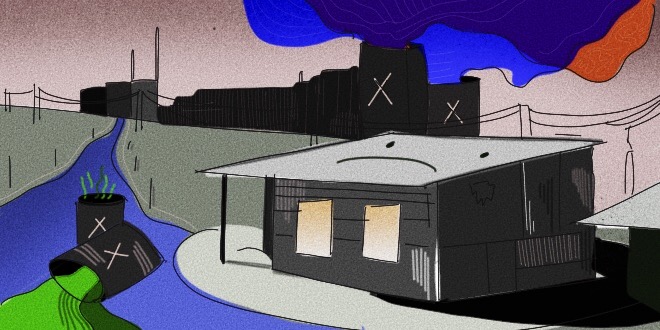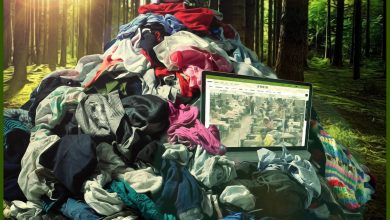Feminism 101: What is Environmental Racism?

Design by Magnolia Midori Casey
Climate change is taking the world by storm, both literally and figuratively. Activism within the environmental crisis is skyrocketing and every corner of media displays the push for climate reforms. Despite its prevalence, environmental activism is often inaccessible for the communities that need it most.
Environmental racism was defined by Benjamin Chavis between the 1970s and 1980s as “racial discrimination in environmental policymaking, the enforcement of regulations and laws, the deliberate targeting of communities of color for toxic waste facilities, the official sanctioning of the life-threatening presence of poisons and pollutants in our communities, and the history of excluding people of color from leadership of the ecology movements.”
In layman’s terms, it is racially discriminatory environmental policies and practices that harm communities of color. The EPA’s Environmental Assessment states that people of color are more likely to live near polluters and that those living within poverty are exposed to far more air pollution. Communities of color are segregated into areas that are at higher risk of heavy levels of pollutant exposure. Racist policies grant the construction of toxic facilities for treatment, and disposal of hazardous toxic waste, close in proximity to communities of color.
Environmental racism stems from institutionalized racism, the oppression against people of color such as disparities in opportunities, income, education, and social and political institutions. Institutional racism paves the way for environmental policy to create further injustice towards communities of color.
These communities face serious attacks on their quality of life, including a lack of clean or accessible water, places prone to environmental damage (i.e. flooding, fires, earthquakes, etc.). They also suffer from exposure to pollutants from hazardous waste dumping sites. To make matters worse, these communities also face a lack of representation in political and social leadership positions.
Due to a lack of representation, alongside a lack of funding from the government within these communities of color, it is difficult for people of color (POC) to oppose hazardous policies and waste within their homes. Since people of color are put at a disadvantage in environmental policymaking, suburbanization and gentrification flourish.
Suburbanization is when white people move from polluted inner cities to the outer suburbs that are cleaner and safer, leaving communities of color stuck living in poor conditions, since many are not economically capable to follow suit. Suburbanization works hand in hand with gentrification, which is when low-income neighborhoods are transformed by reintroducing prosperous businesses. The resulting increase in economic value pushes out low-income families and communities. Both gentrification and suburbanization result in further inequality of low-income people and people of color.
Not only is environmental racism an issue within urban cities, but it also affects Native American communities. A recent example is the Dakota Access pipeline. The construction of this pipeline was meant to increase the boom of oil in North Dakota. Its blueprint mapping passes beneath the main water source and a sacred burial ground of the Standing Rock Sioux Tribe. And as usual, Native American territory is dismissed in order to increase prosperity for more money-hungry white men. The pipeline disrespects the Tribe and carries risks of a burst pipeline, which would contaminate the nearby water source for the Rock Sioux Tribe and surrounding wildlife.
In December 2016, President Obama revoked the permit for the construction of the pipeline. However, soon after, President Trump allowed the construction to occur. It has been an ongoing battle for the Standing Rock Sioux Tribe and continues to be as administrators refuse to acknowledge the catastrophic effects the pipeline would have on Native Americans and the surrounding environment, such as the risk of a pipeline burst which could toxify the water source and kill the surrounding wildlife. Two years later, in 2019, anti-DAPL protestors are still being processed for charges. But protesters continue to fight by filing civil lawsuits against the violence they have faced from police authority around the pipeline’s construction.
The push for environmental reform is increasing as fears of climate change are an ever-approaching reality. The awareness that social media is able to promote has pushed for valuable changes all over the world. However, the narrative of zero waste and hyper-consciousness of personal environmental impact is mainly perpetuated by upper-middle-class white women. Although changes in lifestyle are valuable and do help one’s individual environmental impact, the assumption that it is attainable by every person is ignorant and comes from a privileged mindset.
On a global level, environmental racism affects every country around the world. Malaysia declared that they will be sending back all the garbage that EuroAmerican countries have illegally been dumping onto them in order to transfer responsibility. Wake up America, this is not how to be environmentally conscious. America, as always, takes advantage of developing countries such as Malaysia and these countries have had enough. Rather than making reforms in corporations, industrialization, and in society about garbage and waste it is easier (and cheaper) for greedy America to dump onto a country perceived as lesser.
Corporate greed is the largest impact on environmental waste. Corporations are paid massively to produce cheap products and plastic that cannot be recycled or break down within the environment. The government and society fail to make corporations pay for the environmental harm caused because these corporations fund government officials. It is an endless cycle of corruption and greed. But this is the same society that continuously tries to shove the environmental crisis onto the shoulders of the everyday person.
Even if POC were not affected by the discrimination of environmental policies and could make the same changes in their lifestyles as is broadcasted by white women, the massive deterioration of the environment cannot be blamed on individuals. Corporate greed and the dismissal of pollution due to greed is the real monster we must all face.
Within the world of social media, the scrutiny we place on individuals’ choices alienates people who aren’t able to be vegan, zero-waste, or adopt other inaccessible lifestyle changes. The people who are able to participate in these lifestyle changes are those who are the least affected by environmental injustice.
So yes, we should refuse plastic as much as possible, and it is wonderful to help people find alternatives. But disrespecting people who are trying or even focusing on just trying to survive the discrimination that policy enforces onto them, is vile behavior for anyone who calls themselves an activist. Individual contribution to ending environmental crisis can be effective, however, it is not just through the controversy of straw usage. The corporations you purchase from daily put money into the pockets of those who do the most harm but have blamed you. Direct your focus to the corporations who are not only responsible for the large percent of environmental waste, but also use their money to lobby the people that make the environmental policies that are harming POC.
The fight for environmental justice is ongoing. The fight for sustainability within our lives, cultures, policies, and values within society and our planet needs to be equal for all people. Environmental racism will continue to cause injustice towards communities of color if the fight for environmental justice does not include the fight for racial justice.




